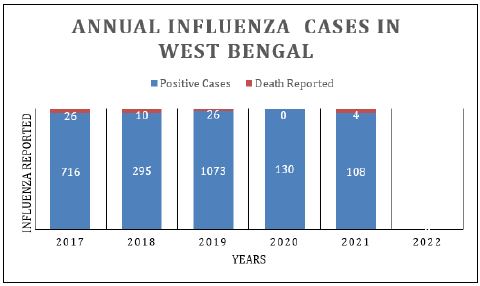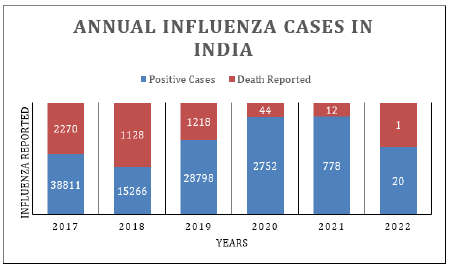- Submissions

Full Text
Research in Pediatrics & Neonatology
Rapid Declination of Influenza Virus Infection After SARS-CoV-2 Outbreak in Kolkata, India: A Significant Risk to the Paediatric Population
Rajendra Prasad C1, Shilpa C2, Suvendu P1 and Reena Ray G1*
1irus Research & Diagnostic Laboratory, Department of Microbiology, R G Kar Medical College & Hospital, India
2irus Research & Diagnostic Laboratory, Department of Microbiology, R G Kar Medical College & Hospital, India
*Corresponding author: Reena Ray G, Department of Microbiology, R G Kar Medical College & Hospital, India
Submission: June 27, 2022; Published: August 09, 2022

ISSN: 2577-9200 Volume6 Issue4
Abstract
SARS-CoV-2 outbreak has overrun the entire globe since its initial appearance in China in December 2019 [1]. The first case of SARS-CoV-2 in India was recorded on January 30, 2020, and Indian officials imposed a country-wide lockdown in March 2020 to stop the virus from spreading [2]. In India, seasonal influenza is caused by a number of circulating influenza viruses, including Influenza-A H1N1, H3N2, and Influenza B. Type A influenza viruses are the only flu viruses known to generate pandemics, as they undergo both antigenic drift and shift, whereas influenza type B viruses only undergo antigenic drift. Between April 2020 and July 2021, only 2,521 influenza A (H3N2) virus cases were recorded from 57 countries, the majority of which came from India (445), Laos (268), Bangladesh (209), and Pakistan (209) During the same time, the bulk of A (H1N1) cases were reported from Ghana (235), Togo (226), the United States (170), and Russia (165). Cases of B/Victoria were mostly reported from China, but some of its clades were also found in Kenya, the United States, Brazil, and Japan [3]. In 2022, according to the National Centre for Disease Control (NCDC), the number of H1N1 cases in whole India is 20, with 1 death, whereas no recorded cases were found from West Bengal (as of 30th April 2022). In 2020, there were 2,752 cases with 44 deaths, compared to 28,798 cases and 1,218 deaths in 2019, the penultimate year before the SARS-CoV-2 outbreak (as of 30th April 2022) (https://ncdc.gov.in/showfile.php?lid=280). Seasonal influenza kills an estimated 2.90-6.50 lakhs people worldwide each year [World Health Organization. (2017, December 13)].
Keywords: Asthma; Anti-Asthmatics drugs; Dental caries
Methodology
Study details
The study was conducted in Virus Research & Diagnostic Laboratory, Department of Microbiology, R. G. Kar Medical College & Hospital, Kolkata, India, during September 2021- June 2022. Our laboratory is in responsible of performing laboratory-based confirmation of viral infections, particularly Influenza Like Illness (ILI) and Severe Acute Respiratory Illness (SARI) from Kolkata and other adjoining districts of West Bengal. The inclusion criteria for reference specimens defined by the World Health Organization (WHO) were followed in this investigation. Along with fever, any four of these symptoms were believed to be indicators of influenza infection, such as headaches, fatigue, cough, sore throat, runny or stuffy nose, body aches, diarrhea, nausea, dehydration, difficulty breathing, and shortness of breath, cyanosis and pneumonia.
Throat and nasal swab samples were collected from SARI ward for the detection of suspected influenza virus infection by the medical technologists. This study was planned to be non-discriminatory in terms of age or gender. During this study period we have selected total 112 patients and employed Real Time Polymerase Chain Reaction (RT-PCR) methods for the detection of all types of influenza infection, if any. All the assays have been performed and analyzed using TRUPCR® H1N1/H3N2 with Inf-B Kit Version 2.0 Real time PCR Kit (made by: 3B Black Bio Biotech India Ltd, Bhopal, India) with the help of Bio-Rad CFX96 platform. Our study represents the current status of influenza virus and its activity in a temperate region of West Bengal Figure 1 and India (Figure 2).
Figure 1: Annual influenza cases in West Bengal.

Figure 2: Annual influenza cases in India.

Result and Discussion
Out of 112 enrolled patients, all of them were negative to all type of influenza virus infection (A/H1N1, A/H3N2, Influenza B) and SARS-CoV-2 infection (tested using one of the Indian Council of Medical Research approved RT-PCR kit manufactured by Angstrom Biotech Pvt Ltd, Rajasthan, India). Among the enrolled patients, only 3.5 percent (4 out of 112) had received influenza vaccination and 20.5 percent (23 out of 112) had received COVID-19 vaccination... The absence of influenza cases in West Bengal this season does not always imply that there won’t be any next in upcoming season. A winter ‘spike’ in the post-monsoon months is possible as the virus will show periodicity. Influenza infections possess higher case fatality rate (deaths per confirmed case) and can have a substantial impact on pediatric population in India.
The sudden declination in influenza incidence can be a disadvantage due to the reduction in herd immunity against influenza virus infection which might encourage the emergence of more serious, long-lasting epidemics. To mitigate the negative consequences of influenza virus infection, it is of utmost important to conduct mass vaccination campaigns and focus on vaccinating the virus’s major carriers; children who are at a high risk of developing serious illness. Because of their lack of pre-existing immunity and prior exposure to the virus, young children have the greatest infection rates with influenza virus. Infection with the influenza virus can lead to secondary bacterial infections in children of all ages [4].
Children above 6 months who wishes to avoid sickness, should have an annual influenza vaccination inoculation. Maternal immunization during the influenza season can help to mitigate the effects of illness in new-borns under the age of 6 months. Members of the family, especially siblings, or any other relatives should get the flu shot to minimize the risk of transmitting to children. Because they do not yet have a COVID-19 vaccination, a flu shot becomes even more important in reducing COVID’s impact and keeping them healthy. Non-Pharmaceutical Interventions (NPIs) also advised to the public to adhere to COVID’s safety precautions, which include wearing a mask around people at all times, staying at home, school closures and maintaining social distance. Children younger than 5 years old, especially those younger than 2 years are at higher risk of suffering significant flu related complications [Centers for Disease Control and Prevention (2021, November 18)]. Influenza, however, is more harmful and worrying in small children, as the sickness strikes sooner than we might imagine, and child’s health could be jeopardized within the first two or three days.
Conclusion
According to our present study, the influenza virus is currently in the decline phase in West Bengal and other parts of India. The unforeseen incidence of disappearance of influenza virus infection should not be overlooked. Re-emergence and epidemics are unpredictably occurring events, but their influence can be avoided by being in the right state of preparedness. Continuous monitoring of influenza activity is crucial because, when it resurfaces, it has a deadly and explosive nature. To improve patient control of ILI, we must stimulate community participation and prevent disease spread. India’s monsoon season has arrived, and the arrival of the rain brings with it a slew of ailments and infections that can pose a serious threat to pediatric and elderly population. Monsoon brings a variety of mosquito-borne diseases mainly influenza and dengue virus infection in Kolkata and different districts of West Bengal.
Vaccination is one of the most important deterrents of seasonal influenza infection, aside from the usual precautions of drinking clean water, eating fresh food, and avoiding mosquito bites. Vaccination, on the other hand, makes the situation avoidable and manageable. While influenza patients develop pneumonia as a comorbidity, it can be fatal in high-risk individuals. However, the influenza virus could return with a vengeance. Long-term suppression of seasonal influenza virus circulation will weaken herd immunity and intensify upcoming influenza virus outbreaks mainly in the pediatric population. It is suggested that department of health should begin to conduct routine influenza surveillance and also recommend annual vaccines round the country.
References
- Sharma A, Tiwari S, Deb MK, Marty JL (2020) Severe Acute Respiratory Syndrome Coronavirus-2 (SARS-CoV-2): A global pandemic and treatment strategies. Int J Antimicrob Agents 56(2): 106054.
- Andrews MA, Areekal B, Rajesh KR, Krishnan J, Suryakala R, et al. (2020) First confirmed case of COVID-19 infection in India: A case report. The Indian journal of medical research 151(5): 490-492.
- Dhanasekaran V, Sullivan S, Edwards KM, Xie R, Khvorov A, et al. (2022) Human seasonal influenza under COVID-19 and the potential consequences of influenza lineage elimination. Nat Commun 13(1): 1721.
- Smith AM, McCullers JA (2014) Secondary bacterial infections in influenza virus infection pathogenesis. Curr Top Microbiol Immunol 385: 327-356.
© 2022 Reena Ray G. This is an open access article distributed under the terms of the Creative Commons Attribution License , which permits unrestricted use, distribution, and build upon your work non-commercially.
 a Creative Commons Attribution 4.0 International License. Based on a work at www.crimsonpublishers.com.
Best viewed in
a Creative Commons Attribution 4.0 International License. Based on a work at www.crimsonpublishers.com.
Best viewed in 







.jpg)






























 Editorial Board Registrations
Editorial Board Registrations Submit your Article
Submit your Article Refer a Friend
Refer a Friend Advertise With Us
Advertise With Us
.jpg)






.jpg)














.bmp)
.jpg)
.png)
.jpg)










.jpg)






.png)

.png)



.png)






